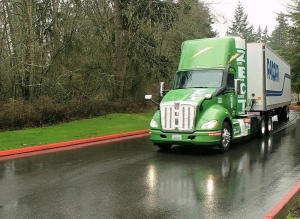Clean Energy Canada | New federal incentives for zero-emission commercial vehicles will put a much-needed dent in Canada’s high transportation emissions
July 11, 2022

OTTAWA — Joanna Kyriazis, clean transportation program manager at Clean Energy Canada, made the following statement in response to the federal government’s announcement of the new Incentives for Medium- and Heavy-Duty Zero-Emission Vehicles Program:
“We welcome the federal government’s new incentives for medium- and heavy-duty vehicles, such as delivery vans, garbage trucks, and long-haul trucks.
“The transportation sector is the second biggest source of emissions in Canada, and commercial vehicles make up more than a third of that. Introducing an incentive program is one of the most effective ways to get more battery electric, plug-in hybrid, and fuel cell electric commercial vehicles on Canada’s roads. The federal government’s similar rebate for passenger vehicles has persuaded many Canadians to make the switch to electric vehicles, and now businesses will find it easier than ever to electrify their fleets, as well.
“The new incentives will cut emissions, save fleet owners money, and support key Canadian manufacturing and export opportunities. Canada is home to several leading zero-emission truck manufacturers, including Quebec-based Lion Electric, which already has an agreement in place to supply Amazon with thousands of medium-duty electric trucks.
“We are especially pleased that many of our recommendations were included in the policy’s design, which incorporates a number of best practices from other jurisdictions that have put similar incentive programs in place. In fact, Canada is following in the tire tracks of at least seven U.S. states with similar systems.
“In terms of next steps, the new program must be part of a broader zero-emission medium- and heavy-duty policy package that addresses both demand and supply barriers. This package should include charging incentives to help fleet operators deploy charging infrastructure alongside a vehicle sales mandate to ensure enough vehicles are available to buy.
“In addition to smart policy design, the federal government should be commended for the speed at which the program was designed and rolled out. Climate change is not slowing down, and our policy response shouldn’t either.”
KEY FACTS
- Canada’s transportation sector is the second-biggest emitter in Canada, making up 24% of the country’s total emission, with heavy-duty gas and diesel vehicles accounting for 37% of that.
- Canada’s Emissions Reduction Plan commits to “launch[ing] an integrated strategy to reduce emissions from medium-and heavy-duty vehicles (MHDVs) with the aim of reaching 35% of total MHDV sales being ZEVs by 2030” and “develop[ing] a MHDV ZEV regulation to require 100% MHDV sales to be ZEVs by 2040 for a subset of vehicle types based on feasibility, with interim 2030 regulated sales requirements that would vary for different vehicle categories based on feasibility, and explore interim targets for the mid-2020s.”
- The federal Budget 2022 set aside $547.5 million over four years (or until available funding is exhausted) for the Incentives for Medium- and Heavy-Duty Zero-Emission Vehicles (iMHZEV) Program
- The program is effective as of July 11, 2022, but incentive requests for reimbursement are not expected to be available until Fall 2022.
- The incentive levels offered are based on the class of the vehicle, with heavier vehicles receiving larger incentives. The incentives aim to cover approximately 50% of the price difference between an electric vehicle and a traditional vehicle. Public transit and school transportation are excluded from this program given their coverage in other federal incentive programs.
- According to the U.S. Department of Energy’s Alternative Fuels Data Center, at least seven U.S. states have some form of MHDV incentive program, including California, Illinois, Massachusetts, New York, New Jersey, Vermont and Virginia. California’s Hybrid and Zero-Emission Truck and Bus Voucher Incentive Project has helped to deploy more than 3,000 zero-emission trucks and buses since 2010, with 61% of all zero-emission trucks deployed in the U.S. having gone to California.
RESOURCES
Clean Energy Canada’s submission to Transport Canada | Incentives for Medium and Heavy Duty Zero Emissions Vehicles Program